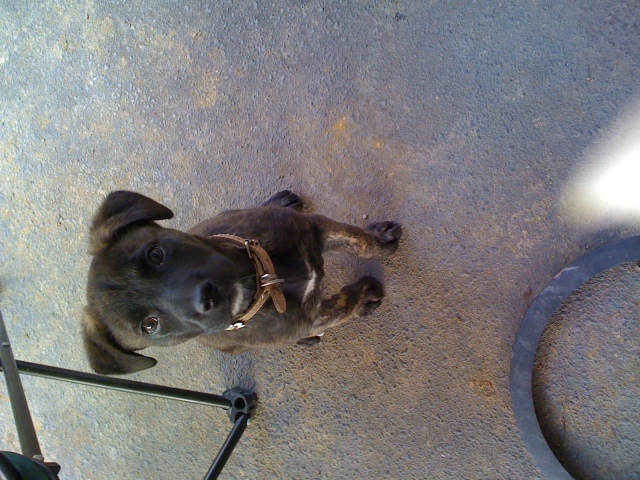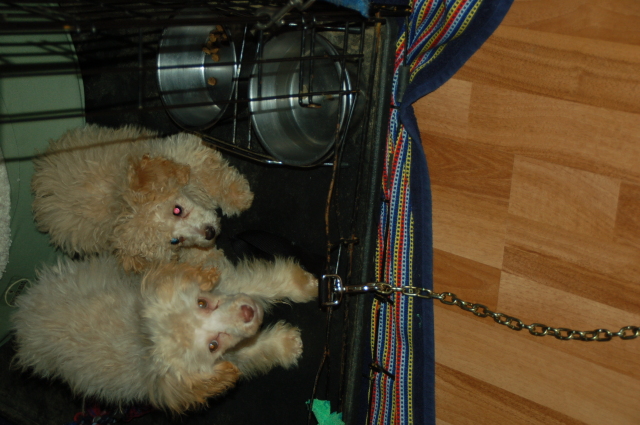QuestionHi, we have just recently gotten a puppy who is a couple of months old now, and we have started putting his bed in the laundry and shutting him in there at night. However he really hates it, and will constantly cry and bark and scratch at the door, which we just ignore. How can I get him to calm down? Thanks for your time
Answer
What does a puppy need?
A crate. It is only natural that a puppy resists its crate at first. What the puppy wants more than anything else is to be others, you, anyone else in the household, and any other pets. In our modern society, even if we are home, other things distract us from the attention an uncrated puppy must have. The only real solution is to crate the dog when you can't give it tha attention it needs. The dog may be happier in its den than loose in the house. It relaxes, it feels safe in its den. It rests, the body slows down reducing the need for water and relieving its self. Dogs that have been crated all along do very well. Many of them will rest in their crates even when the door is open. Skip the bedding. At first it gets wet, and later it can be chewed into choking hazards. A wire rack in the bottom will help keep the puppy up out of accidents at first. They are available with the crates, but a piece of closely spaced wire closet shelving from a home supply place is cheaper. I think the plastic ones give the dog more of a safe, enclosed den feeling. Metal ones can be put in a corner or covered with something the dog can't pull in and chew. Select a crate just big enough for the full grown dog to stretch out in. At first, you may need to block off most of it. At bed time, with a new puppy, I have found lying down in front of the crate like you were going to sleep and speaking softly to it, or singing, until it settles down and goes to sleep works very well. Follow the pattern, a period of active play, outside to eliminate, and then into the crate.
Socialization. Not just with dogs, but the human world dogs need to be comfortable in. There is a very narrow window to do it. Before 6 weeks pupies need to be with their mother and litter and ignore everything else. After 12 weeks they quite accepting new things. See http://www.apdt.com/veterinary/assets/pdf/Messer_ND06.pdf
Chew toys. The pet stores are full of toys that many dogs will quickly chew up into pieces they could choke on or cause intestinal blockages. If you are not there to watch, stick to sturdy stuff such as Nylabones and Kongs. Keep a close eye on chew toys and quickly discard anything that is coming apart in pieces. Rawhide is especially bad because it swells after being swallowed. These problems are the worst with, but not limited to, large, aggressive chewers such as Labs.
Food. Find out what the breeder is feeding. If it is dry chow you can buy readily, I would stick with it until the dog is 4 months old, at that time switching to a dry all life stages food. If not, try to have the breeder give you a few days supply to use making a gradual change to a dry puppy chow. In most cases, your best bet is to stick with the breeders food. Many people that switch to ''better''foods have trouble.
Dishes. Empty plastic food containers are good enough. If you want something nicer, buy the spill proof? ones, stainless steel with an outer skirt making them hard to tip or pick up. I have found them at Big Lots.
A collar and leash. You should stay with a flat fabric or leather collar until your puppy is 5 months old. I start the puppy out with a metal leash and switch to a leather one after the worst of the chewing is over and I need more control. The trend is away from the metal collars to Martingale or head collars. They can be used with younger puppies too.
A name, try http://www.lowchensaustralia.com/names/petnames.htm#1 and http://www.cat-dog-names.com/
A brush. Start the puppy with a soft bristle brush. They don't shed much at first, and the bristle brush will remove dirt and help control odor. I use a pin cushion brush for seasonal shedding. I fine it as effective as a slicker brush, but more comfortabe for the dog.
The number of a vet. It is very hard to evaluate them. Dogs need more medical care than in the past. Many new problems are wide spread.
A book. Any book is better than none at all. I like the Monks of New Skete and their The Art of Raising a Puppy, ISBN 0-316-57839-8.
Obedience training. A good obedience class or book is about you being top dog, not about rewarding standard commands with a treat. Start obedience training the day you get the dog. Build on the foundation of housebreaking. The younger the puppy, the shorter you must keep sessions, only a few repetitions at a time. A few minutes here and there, and by the time the puppy is 4 months old, people will be impressed with what a nice dog it is.
An All Experts bookmark so you can come back for help as needed.

 Puppy Teething, Jumping, Bathing and Ear drops
Question
Puppy Trinnie
Hi, I have a 5 & 1/2 month old S
Puppy Teething, Jumping, Bathing and Ear drops
Question
Puppy Trinnie
Hi, I have a 5 & 1/2 month old S
 Pomeranian digging in beds and clothes
Question
Charlie my Pomeranian
I have a Pomeran
Pomeranian digging in beds and clothes
Question
Charlie my Pomeranian
I have a Pomeran
 Chewing and ripping apart
Questionbut... im a full time student..... walk her dai
Chewing and ripping apart
Questionbut... im a full time student..... walk her dai
 puppy behavior
Question
Cooper and Guy
Hi, thanks so much for reading
puppy behavior
Question
Cooper and Guy
Hi, thanks so much for reading
 chihuahua pees on bed
Questionme and boo
QUESTION: I have a 9 month ol
chihuahua pees on bed
Questionme and boo
QUESTION: I have a 9 month ol